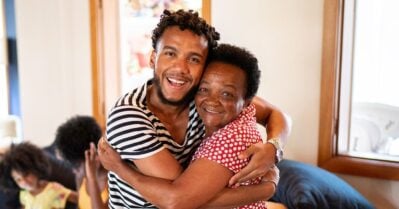Helping Families Thrive With B’more for Healthy Babies
A Q&A With Michael Camlin

Launched in response to Baltimore City’s one-time record high infant mortality rate — more than 13% in 2009 — B’more for Healthy Babies (BHB) has united more than 150 public and private partners to improve family health and well-being across the city.
The initiative, funded by the Annie E. Casey Foundation, is led by the Baltimore City Health Department with support from the Family League of Baltimore, Health Care Access Maryland and other local partners.
In this Q&A, Casey Foundation Senior Associate Michael Camlin discusses BHB, Baltimore’s declining infant mortality rate and the initiative’s impressive results over the past 15 years.
Q: The Foundation works to create a brighter future for children and their families. How does health care play a role in that mission?
Camlin: Health is connected to everything the Casey Foundation does, from education and employment to mental and financial well-being. And this is especially important during critical periods like pregnancy and infancy, when the health of a mother and child is most vulnerable.
Millions of Americans are unable to get the health care they need. But we know that when people can easily access essential treatment — like regular checkups for new or expecting moms — they are healthier and able to live more stable, fulfilling lives.
Q: Tell us about B’more for Healthy Babies. What impressed you about the program?
Camlin: B’more for Healthy Babies brings together a network of communities, organizations and resources so that every baby born in Baltimore can have the best start possible. It works to reduce infant mortality in the city by improving health before pregnancy, ensuring quality care during pregnancy, supporting families to raise healthy babies and making sure all families can access the care and services they need.
I’ve been impressed with BHB’s results and its explicit focus on removing barriers to better infant and maternal health in neighborhoods facing the greatest challenges. In Baltimore, Black babies are more likely to be born premature or underweight. Black infants were also much more likely to die prematurely when BHB launched in 2009.
BHB has achieved significant results over the past 15 years. By focusing on the Baltimore neighborhoods with the highest rates of infant mortality, it has helped decrease the city’s overall infant mortality rate by 35%.
Q: Why do you think B’more for Healthy Babies has been successful?
Camlin: BHB has been able to achieve so much because of its collective impact model. It brings together people from different systems across the city — the health department, hospitals, clinics, social service providers, parents, faith-based institutions and many others — to work toward a common goal of reducing infant mortality while improving maternal and child health in the city.
The result is a more coordinated system aligned on goals, messaging and resources that reach mothers and families throughout their lives, whether it’s at a prenatal care visit, during a flu shot or in the ER finding out they’re pregnant for the first time.
Another reason BHB’s work has yielded such great results is its use of data to track maternal and child health. The data allow them to assess the drivers of maternal and infant mortality in the city, using a continuous improvement process to adapt and respond as the environment changes. For example, when sleep-related infant deaths began rising in Baltimore, BHB responded by launching a “Safe Sleep” campaign to educate parents on safe sleep practices and drive down sleep-related deaths.
Q: Substance abuse and overdose have become leading causes of maternal mortality in Maryland. How has B’more for Healthy Babies responded?
Camlin: BHB is now state-certified as an Overdose Response Program. That means it can educate medical professionals, social service providers and Baltimore residents about overdose prevention and train them in how to use naloxone to reverse an overdose.
As part of this new focus, health care providers across Baltimore are learning how to better assess and respond to substance use disorders and ensure that expecting mothers and their families are educated and equipped to prevent and respond to an overdose.
Q: What is B’more for Healthy Babies focused on going forward?
Camlin: BHB is making exciting progress in multiple ways. Last year, a third community site in Cherry Hill joined the existing BHB communities in Upton/Druid Heights and Patterson Park North/East. The results we’ve already begun to see in Cherry Hill and around South Baltimore have been very promising.
BHB also recently launched a new city-wide Provider Portal to gather and disseminate resources for prenatal and postpartum providers, health care administrators and early childhood providers across Baltimore. This latest effort from BHB’s strategic communications campaign will host a regularly updated resource directory for health care providers across the city.
Lastly, BHB is documenting its model to help communities outside of Baltimore City replicate its success. For example, the Pritzker Traubert Foundation is working to replicate the initiative in Chicago and four other locations across the United States. It’s incredibly exciting to see BHB begin to share what it has learned with the rest of the country.






